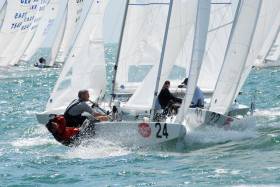Displaying items by tag: Star Europeans
Maurice ‘Prof’ O’Connell joins the media team for next week’s Star Europeans and Star Sailors League on Lake Garda.
The professional sailor and coach, and one-design expert with North Sails Ireland, will be providing the in-studio commentary and analysis with Digby Fox for live action on StarSailors.com along with Shirley Robertson who will be out on the water.
Prof is no stranger to broadcast sailing coverage, having been in the RTÉ studios for the last three Olympic Games — and he’s certainly no stranger to the Star class, with his final race at the Star Worlds in Miami only 11 years ago.
This year Ireland’s focus will be on the O’Leary brothers Peter and Robert, set to compete against a who’s-who of the racing world from this Wednesday 15 May.
Star Europeans Draw to a Close
The 132-boat Star Europeans finished their six-race series in Viareggio, Italy, with the Germain pairing of Johannes Polgar and Markus Koy taking the win with a consistent showing.
The Irish boats finished just outside the top 30, with Max Treacy and Anthony Shanks emerging ahead of their London 2012 rivals by just nine points, finishing in 31st place overall. Peter O'Leary and David Burrows ended the regatta in 33rd place, after counting an 88th and 35th in their last two races.
The official website (for what it's worth - and that's not a lot) is HERE.
O'Leary/Burrows Keep it Consistent at Star Europeans
The O'Leary/Burrows pairing posted a respectable 12th yesterday in the 132-boat Star Europeans in Italy, keeping them close to the top. Discards come into play after today's race, and on current points, the Treacy/Shanks team have a 20-point deficit to make up, despite standing to discard a 95th. They lie in 37th at present.
At the top, the German team of Polgar Johannes and Koy Markus, who have led from race one, had their first slip, posting a 21st, which allowed the second-placed team steal a march on the leaders and come within one point.
The relatively worthless Star Europeans website is HERE.
Treacy & Shanks Close the Gap at Star Europeans
With a fourth place in today's race, Max Treacy and Anthony Shanks are perfectly placed to take advantage of the discard when it comes into place and move up the leaderboard.
The Irish crews lie in 28th and 44th overall after three races, with the O'Leary/Burrows pairing ahead. If you take away the worst score from both teams as things stand, they are on equal points, with 52 points net, meaning that they are, in effect, even stevens.
After some initial inconsistency, the top ten is full of familiary names, with Torben Grael, George Szabo, Mateusz Kusznierewicz, Mark Mendelblatt and Xavier Rohart all within striking distance of the top, and more world champions within the top 20.
Results to date are HERE.
Irish Star Crews Arrive in Italy
Ireland's two Star crews line up against each other next week for the first time in what will be their final configurations. Both crews take part in the Star Europeans in Villareggio, with a record entry of 149 boats, all sailing the one start line and the one course.
Max Treacy and Anthony Shanks will take to the water against Peter O'Leary and former Olympian David Burrows, who pair up for the first time in competition.
Registration and practice takes place over the weekend, with racing starting on Monday.
News, when it emerges, will feature on the OFFICIAL WEBSITE.




























































